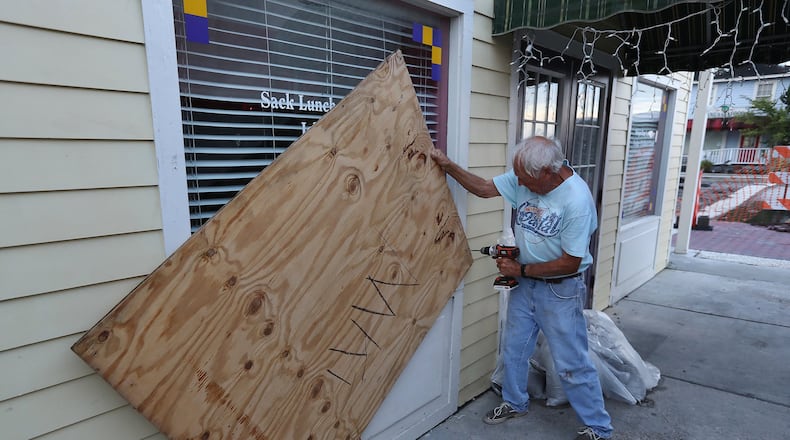Residents of coastal Georgia were breathing easier on Thursday after Hurricane Dorian passed through leaving the coast largely unscathed. The devastation that Dorian brought to the Bahamas and severe weather it was taking to the Carolinas, never showed in Georgia.
>> Read More: 'Thank goodness we were spared.' Dorian leaves minor damage along Georgia coast
The state was spared this time. But with hurricane season in full swing, forecasters warn we’re not out of the woods yet.
As Georgia Power worked to restore electricity to thousands of customers early Thursday, other residents on the coast began the process of unboarding their businesses. With evacuation orders and curfews lifted, some also began returning to their homes.
Crystal Smith, who was working at the Raceway gas station off I-95 in Camden County, lives just across the state line of the St. Marys River in Yulee, Florida. She said the lights flickered once in her home. “I thought it was going to be worse than Matthew and Irma,” she said, relieved at how Dorian played out for coastal Georgia.
From the start, Gov. Brian Kemp made clear his take-no-chances approach. For several days, as Dorian held the potential to significantly impact the Georgia coastline, Kemp made the choice to err on the side of caution rather than be caught off guard.
Dorian, however, would surprise even seasoned meteorologists.
Dorian’s changing path
The first advisories for Dorian came in late August, and five days out, the path overall was very well forecast, said Cindy Elsenheimer, meteorologist and emergency response specialist for the National Weather Service Southern Region Headquarters in Fort Worth, Texas.
Hurricanes are steered by winds in the midlevel of the atmosphere. Dorian initially was tracking around a high pressure system to the north. This Bermuda High pressure system, which sits over the Atlantic in the summer blocking the path of hurricanes, began pushing Dorian west to the Bahamas, where it made landfall as a Category 5 storm. But instead of moving on, it stalled in the weak to nonexistent steering flow (the wind flow that guides hurricanes), lumbering forward at 1 mph.
“It is very rare to see that happen over land, such as what occurred in the Bahamas a few days ago,” said Georgia Tech instructor Zachary Handlos, who recalled how Hurricane Harvey stalled over Houston in 2017, leaving one-third of the city underwater.
And so Dorian, locked in a push and pull between pressure systems, ended up moving northward as a Category 2 storm, away from Florida and the Georgia coast and heading for landfall again in the Carolinas. “Hurricanes are looking for the path of least resistance,” Elsenheimer said.
>> PHOTOS: Hurricane Dorian's outer bands reach South Georgia
"El Nino (the periodic warming of the Pacific Ocean near the equator) typically suppresses Atlantic hurricane activity, but now that it's gone, we could see a busier season ahead," said Gerry Bell, Ph.D., lead seasonal hurricane forecaster at NOAA's Climate Prediction Center, in a statement.
The number of predicted storms for this current hurricane season, which runs from June to November, is between 10 and 17 named storms with winds of 39 mph or greater. Of those storms, five to nine will become hurricanes, including two to four major hurricanes with winds of 111 mph or greater. There have been seven named storms this year, including Fernand, which made landfall as a tropical storm in northeastern Mexico on Wednesday, and Gabrielle, a newly named tropical storm currently swirling in the Atlantic, where it is expected to stay.
While meteorologists can’t predict how the remainder of the season will play out, the potential for a hurricane making landfall in Georgia is pretty small compared to other states in the region, said Kurt Van Speybroeck, meteorologist for the National Weather Service. States like Florida and Texas have more coastline, which opens them up to the possibility of more hurricane activity. But in the end, he said, ”during hurricane season, everything is up for grabs.”
Dorian’s aftermath
For now, with Dorian in the rearview mirror, local officials consider themselves lucky.
“We have not received any reports of any injuries or any fatalities from this storm,” said Dennis Jones, Chatham County’s emergency management director, to reporters Thursday afternoon. “Very minor damage throughout our community. The biggest thing is the power outages.”
The hurricane caused 65 mph gusts and three-and-a-half-foot storm surges on Tybee Island, he said. Trees and wind took down power lines in coastal communities where on Thursday residents awaited an assist from 1,500 additional utility workers traveling in from Atlanta.
About 5,000 area residents were still without power as of Thursday afternoon, down from more than 15,000 in the morning. Savannah’s Talmadge Bridge reopened to traffic, and Savannah and the town of Thunderbolt canceled their curfews.
>> RELATED: Where, how you can help Hurricane Dorian victims in metro Atlanta
“We will thank the Lord for what we have been through and how we have come out of this,” Savannah Mayor Eddie DeLoach said, “and I hope we move forward along with everybody else in the community.”
U.S. Rep. Buddy Carter, R-Pooler, called the region “lucky.” “Thank goodness we were spared,” he said. “And we are grateful for that. And we remember those who were impacted.”
Officials in Camden and Glynn counties also cited minimal damage.
Glynn County spokesman Matthew Kent said the bridges to Jekyll Island and St. Simons Island remained open and there was minimal damage in the area.
More than 2,000 people stayed at 13 Red Cross Evacuation Centers around the state Wednesday night, the organization reported.
Coastal residents who had evacuated to Atlanta Motor Speedway began pulling out as early as Wednesday, said Dustin Bixby, vice president of marketing and promotion. As many as 40 people were on-site over the weekend, but that number was down to about a dozen on Thursday, he said.
Those who had come the earliest, feared the worst, Bixby said, and they were happy to have escaped Dorian’s wrath. “There were a lot of people that were here saying ‘I’m not risking it’,” Bixby said. “Most people were for the most part just relieved.”
The Latest
Featured







